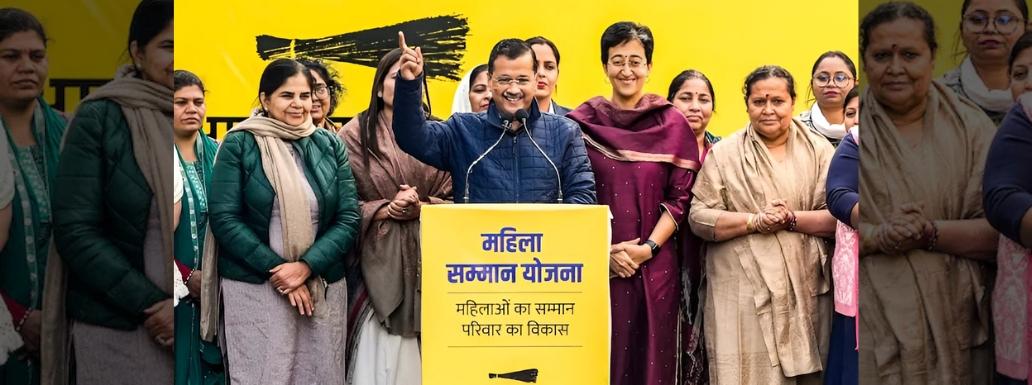Monday 17 November 2025
Delhi Assembly Elections 2025: AAP’s Struggles and the Challenges from Congress and BJP
Share

As the 2025 Delhi Assembly elections approach, the Aam Aadmi Party (AAP) finds itself navigating a critical juncture in its political journey. With mounting anti-incumbency sentiments, corruption allegations, and a resurgent Congress threatening to reclaim lost ground, AAPs campaign is being closely watched. Adding to the pressure is the incarceration of its leader and former Chief Minister Arvind Kejriwal, casting a shadow over the partys bid to retain power for a third consecutive term. The Bharatiya Janata Party (BJP), though yet to release its candidate list, looms large as a formidable challenger.
The AAPs strategy revolves around leveraging its welfare initiatives, revamping its candidate roster, and addressing anti-incumbency. The party has announced two lists of candidates, naming 31 individuals for the February 2025 elections. Among them, 16 sitting MLAs have been dropped, signaling an effort to rejuvenate its lineup. This includes reassigning prominent leaders like former Deputy Chief Minister Manish Sisodia and Vidhan Sabha Deputy Speaker Rakhi Birla to new constituencies.
The party has embraced political turncoats, fielding six defectors from the BJP and Congress in its first list and 13 more in the second. This mix of fresh faces and experienced defectors aims to bolster its chances in constituencies where the partys influence may be waning.
True to its ethos, AAP is doubling down on welfare promises. Kejriwals announcement of the Mukhya Mantri Mahila Samman Yojna, providing a monthly allowance of Rs. 1,000 to women, which would rise to Rs. 2,100 post-election, is a bid to consolidate support among female votersa demographic instrumental to its past victories. Additionally, the party has promised Rs. 10 lakh life insurance and Rs. 5 lakh accident insurance for auto drivers, harking back to its 2013 campaign when autorickshaw drivers played a pivotal role in mobilizing support.
Initiatives like free electricity, water, healthcare, and education remain central to AAPs narrative. The Revdi Par Charcha (discussion on freebies) initiative has seen citywide engagement with citizens, countering criticism from BJP that such measures amount to populism rather than governance.
The partys governance model, once celebrated, faces scrutiny amid allegations of corruption in Delhis excise policy and other administrative challenges. The reshuffling of candidates and the replacement of sitting MLAs reflects AAPs acknowledgment of vulnerabilities in some constituencies. Moving leaders like Manish Sisodia and Rakhi Birla to new seats underscores the need to mitigate risks from anti-incumbency.
The Congress first list of21 candidatesfor the Delhi Assembly has added intrigue to the election. Notable figures include Sandeep Dikshit, son of three-time Chief Minister Sheila Dikshit, contesting from New Delhi against Kejriwal. With candidates like former Minister Haroon Yusuf and ex-Delhi Congress President Anil Kumar, Congress is attempting to reassert itself in its traditional strongholds, targeting the AAPs voter base among Muslims, Dalits, and residents of unauthorized colonies.
Despite being allies in the national INDIA bloc, AAP and Congress have ruled out an alliance in Delhi. This competitive dynamic could fragment the anti-BJP vote, benefiting the saffron party. Congress focus on reconnecting with grassroots workers and leveraging its historical influence in the capital poses a direct threat to AAPs dominance.
While the BJP has yet to release its list of candidates, its role as a challenger cannot be underestimated. The partys efforts to consolidate its voter base, combined with AAPs perceived governance lapses, make it a significant player. The BJPs criticism of AAPs freebie culture and its focus on national issues like uniform civil code and development-oriented governance aim to position it as a viable alternative.
The 2025 Delhi Assembly elections are shaping up to be a three-way contest, with AAP striving to overcome anti-incumbency and retain its stronghold, Congress aiming for a comeback, and BJP seeking to expand its influence. With high stakes and intricate political maneuvering, the battle for Delhi promises to be a litmus test for all three parties. As the campaign unfolds, the electorates verdict will reflect not only on governance but also on the ability of each party to adapt, connect, and deliver on its promises.
Newsletter
Stay up to date with all the latest News that affects you in politics, finance and more.